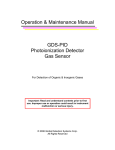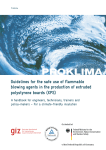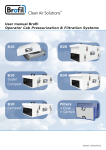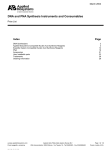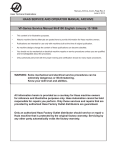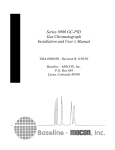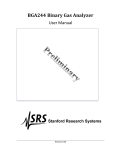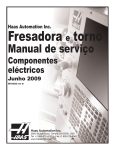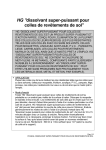Download Introduction
Transcript
Introduction This Manual will familiarize the customer with the Baseline MOCON VOC-TRAQ using the piD-TECH® plus photo ionization sensor. This includes the principle of operation, technical characteristics, as well as some PID-specific application features. The Manual will instruct customers to easily operate the VOC-TRAQ and the TRAQ-WARE software. Section 1 1.1 VOC-TRAQ Overview Portable Photoionization Detector (PID) The VOC-TRAQ total volatile organic compound (TVOC) detector is an excellent way to monitor and record TVOC’s. It operates using any PC with a Windows® operating system. Using the award winning Baseline®-MOCON® piD-TECH® plus photoionization detector makes the VOC-TRAQ the most reliable, accurate, and inexpensive portable TVOC detector on the market. Designed for ease of use all air quality consultants, safety engineers, maintenance managers, or anyone concerned about TVOC’s in the indoor environment. The USB compatible VOC-TRAQ can operate while connected to a PC or it can remotely store up to 36,000 sample readings with the detector’s internal memory using the optional rechargeable power supply. Alarm levels are programmable with LED and/or audible notification. The VOC-TRAQ is also compatible with numerous USB accessory options. The VOC-TRAQ is a simple compact design for monitoring TVOC’s in most environments. The included software allows easy calibration, setup, display and analysis. The VOC-TRAQ consists of a cylindrical housing equipped with a USB port and a 3 color LED. On the top, there is are slotted openings that serve as an entrance for analyzed gas The photo ionization detector and associated electronic circuits are located inside the housing. The LED indicates: • Slow (~ once every 5 sec) Blinking Green = power on and operating. • Blinking Red = Alarm level exceeded. The greater the concentration exceeds the alarm level the faster the flashing. • Blinking Yellow = Alarm event occurred then returned below alarm level. The USB port provides: • USB 5 VDC power for operation (PC, wall connected USB power supply, or optional battery pack). • USB to PC communications to TRAQ-WARE. Refer to Appendix for serviceable items. Section 2 VOC-TRAQ Installation, Calibration & Operation 2.1 Installing VOC-TRAQ Software Insert the VOC-TRAQ Software Installation disk and follow the instructions. When complete the VOC-TRAQ drivers and the TRAQ-WARE software will be installed and ready to use. Be sure to restart your computer after installation. 2.2 Powering Up the VOC-TRAQ Connect the USB cable to your computer and then connect the VOC-TRAQ. Note that the VOCTRAQ goes through a initialization sequence upon power up (flashing red LED with beep, flash amber, flash green, then beep). 2.3 VOC-TRAQ Connection & Control 2.3.1 Start: Open the TRAQ-WARE and select the “Control” tab. The display above will appear. From the COM tab select the VOC-TRAQ COM Port then “Connect”. Note: If you are not sure what COM port is the VOC-TRAQ check in Windows “Device Manager” and look under “Ports”. The VOC-TRAQ is identified as the “USB Serial Port”. 2.3.2 Set Time: Select “Set” Date, Time. Your PC’s date and time will be set into the VOC-TRAQ. 2.3.3 Get Parameters: Select the “Get Parameters” tab and the data from the VOC-TRAQ will be displayed. 2.3.4 Parameters: Version: displays level of firmware on VOC-TRAQ Period, Sec: displays the time between data samples. Any integer can be entered to set the data sample time in seconds. Press “Set” after entering. Start Delay, min: displays the time delay in minutes from power up until data sampling begins. Any integer can be entered to set the sample delay time in minutes. Press “Set” after entering. Zero delay is normal. Memory Used, %: displays the amount of VOC-TRAQ on board memory is used. To clear memory select “Clean”. Alarm Level, ppm: displays the Alarm Level set. Enter the alarm level desired and press set. The LED alarm indication: • Slow (~ once every 5 sec) Blinking Green = power on and operating – No Alarm. • Blinking Red = Alarm level exceeded. The greater the concentration exceeds the alarm level the faster the flashing. • Blinking Yellow = Alarm event occurred then returned below alarm level. Audible Alarm: Set “on” or “off” to turn on or off the audible beep with alarm. Reset Alarm: Press reset to turn off amber “alarm occurred” LED on VOC-TRAQ Sensor Type: If the PID sensor is changed the sensor type can be selected. 2.4 Zero Calibration The VOC-TRAQ should be allowed to stabilize for 15 minutes to an hour before performing a calibration. As a rule, calibration of the sensor on a daily or weekly basis is recommended. However, if the sensor is used in a relatively clean environment, the calibration frequency can be longer. 2.4.1 Select the “Calibration” Tab. 2.4.2 By Calibration Information select “Get” 2.4.3 In the box next to “Zero Concentration, ppm:” enter the ppm value of your zero gas (usually 0.00). 2.4.4 Using the calibration cap apply zero gas to the VOC-TRAQ. A stabilization period of one minute or more should be allowed for zero gas and span gas when they are applied to the sensor during a calibration. 2.4.5 Select the “Set” button next to Set Zero to calibrate the zero value. When selecting the Calibration function the program will automatically switch to a 1 second data collection interval for easier calibration. It will switch back when the Calibration function is exited. 2.5 Span Calibration 2.5.1 In the box next to “Span Concentration, ppm:” enter the ppm value of your span gas. 2.5.2 Using the calibration cap apply span gas to the VOC-TRAQ. A stabilization period of one minute or more should be allowed for zero gas and span gas when they are applied to the sensor during a calibration. 2.5.3 Select the “Set” button next to Set Span to calibrate the Span value. This completes the Calibration. 2.6 Log File Log File: Here data files can be “Browsed”, created and opened. Enter any file name & open. 2.7 Operation 2.6.1 Live: Select “Live” Tab to show the display above. 2.6.2 Show Alarm: Select the “Show Alarm” box to display the alarm level on the graph. 2.6.3 Bottom Button Selections: Start: Starts the VOC-TRAQ data display (default). Stop: Stops the VOC-TRAQ data display. Clear: clears the data shown on the graph. Start Log: Starts the VOC-TRAQ on board data logging. Stop Log: Stops the data logging. Show Live: Return to actual graph after browsing data. Open: Opens a data file. There will be a prompt to choose a file name and location. Save: Saves the data displayed. There will be a prompt to choose a file name and location. This can save actual data as well as “Mem” data. Mem: This tab is accessible once the “Stop” button is selected. The VOC-TRAQ memory can be displayed. It can take up to 4 minutes to download In the picture above a bar graph count down indicates the download % completion. The internal memory provides more than a week of data - data interval set to 20 sec. 2.8 Dynamic Data Display Hold the “ctrl” key and drag the mouse to enclose a desired section of graph. . Release mouse key and the enclosed section will be displayed. Right click and select “Help”. The display “Help” menu will appear. These commands give the user control over the graphic display. 2.9 Skins This pull down menu allows the selection of different color schemes as desired. . 2.10 About Section 3 3.1 VOC-TRAQ Specifications Sensor: Baseline®-MOCON®, Inc. piD-TECH® plus photoionization detector with 10.6eV Lamp Available Dynamic Ranges (Isobutylene): Part #042-963 0.02 to 20ppm (Silver piD-TECH® plus) Part #042-962 0.2 to 200ppm (Bronze piD-TECH® plus) Part #042-961 2.0 to 2000ppm (Black piD-TECH® plus) Target Gases: VOCs and other gases with Ionization Potential <10.6 eV - See Appendix I for an Ionization Potential list. Operating Temperature: -4 to 104 °F (-20 to 40 °C) Operating Humidity: 0 - 90% RH, non-condensing Response Time: T90 10 seconds typical Accuracy: +/- 3% of reading, w/ constant temperature and pressure Dimensions: 1” dia x 3.6” H (2.5cm dia x 9.1cm H) Weight: 1.9 oz (54 g) Internal Memory: 2 Mb EEPROM Memory with programmable sample frequency Output: USB Power: Powered from USB (5.0 VDC, 40 mA) or power supply Calibration: Software controlled Computer Requirements: Windows XP/Vista/7 PC or equivalent via USB Lamp Energy: 10.6 eV Humidity Response: < 1ppm @ 90% r.h. Humidity Quenching Effect: < 15% @ 90% r.h. Serviceable Parts: Lamp, detector cell, filters Warranty Period: 18 months Section 4 Performance and Maintenance 4.1 Span Drift A sensor’s response to gases may change with time. The common term for this is “Span Drift”. The main reason for this drift is typically contamination of the lamp’s window. If the sensor is being used for ambient air applications or applications involving samples containing heavy compounds and/or particles, the lamp window will get contaminated. The rate of the window contamination is a function of the sample gas condition, i.e. how badly it is contaminated with chemicals and particles. Contamination of the lamp window can cause partial UV light blocking, which in turn will reduce the detector’s sensitivity. In this case, more frequent calibration is needed and periodic cleaning of the lamp lens. For lamp cleaning instructions refer to Appendix III. Most VOC’s (e.g. isobutylene, benzene) do not contaminate lens and the drift is very small. Typically, span drift does not exceed 10-15% per month of continuous operation. In favorable conditions over a six month period, span drift may be between 15 and 30%. However, some compounds (such as silicones) are deposited on the lamp window at a more rapid rate. In those circumstances, span drift may be up to 10-20% over an eight hour period. Also dirt, dust, cleaners, smoke, perfume, etc. in the air can contaminate the lamp window requiring more frequent cleaning. 4.2 VOC-TRAQ’s Life Span The life span of the VOC-TRAQ is basically unlimited; however, there are several PID components that will periodically need replaced depending on the amount of use and the sample that is applied to the sensor. The UV lamp has a small irreversible internal degradation over time but is insignificant until after 6000 hours of operation. The lens of the lamp can also become contaminated over time if it is exposed to samples containing heavy compounds and/or particles. Periodic calibration of the sensor will compensate for the lamp degradation. If the sensor is used for measuring low-level contaminations in pure gases, it will last as long as the lamp, i.e. >6000 hours without cleaning the lamp or servicing the PID. All PID replacement parts including the lamp, cell assembly, and filters are listed in Appendix III. 4.4 Temperature Effect The VOC-TRAQ has a normal operating range from -20ºC to 40ºC. It will operate safely up to 60ºC without damage, however the performance of the VOC-TRAQ is not guaranteed at this elevated temperature. Ambient temperature changes do have an effect on the PID performance. The VOC-TRAQ contains temperature correction to adjust the output to compensate for temperature variations. The variance over the specified temperature range is typically less than plus or minus 5%. 4.5 Response Factors The ratio between the sensitivity of Isobutylene to that of a target compound is called a Response Factor (RF). For example, VOC-TRAQ has a typical sensitivity of 1mV/ppm for Isobutylene and 2 mV/ppm for Benzene. That means that Benzene’s RF is equal to 0.5. Response factors vary to some extent from one PID detector design to another. The response factors are available from various reliable literature sources. The response factor table (Appendix II) allows the user to measure concentration of various gases without actually calibrating the sensor with the target gas. The following facts and guidelines should be kept in mind while using the response factor table: 1. 2. 3. 4. 5. All response Factors were measured in laboratory conditions, with Isobutylene as a reference compound and dry air as a balance gas. The actual values of Response Factors may vary in customer’s application, depending on the measurement conditions (sample humidity, background gas, lamp condition). Response Factors should be used for the approximate measurements, when calibration with the actual target compound is not feasible. For the best accuracy, the instrument should be calibrated with the target compound, under the application’s conditions. Certain gases although they have a response factor tend to be unstable and can cause a photo-chemical reaction in the PID detector. This reaction can cause some unpredictable results. An example of this is NH3 (Ammonia). 4.6 Response Time (T90/T10) The time it takes for the signal to go from 0% to 90% of the target gas applied is referred to as the T90 response time and from 100% to 10% is called the T10 response time. The VOC-TRAQ response time is 10 seconds typical and less than 20 seconds maximum. Note that the response time is based on the response of the VOC-TRAQ and not the sample delivery system. 4.7 Humidity Effects The VOC-TRAQ Humidity Response to Moisture pure Hydrocarbon Free (HCF) air is applied to the sensor, with some humidity present in the sample. The maximum expected shift does not exceed ±1.0 ppm (Isobutylene). For improving the accuracy of low level measurements, it is recommended to zero the VOCTRAQ at the same level of relative humidity (RH) as expected in the sample. The VOC-TRAQ has a relatively flat response to humid environments (see graph below). NOTE: Sudden changes in humidity can cause a temporary shift in output. Allow up to 15 minutes for the VOC TRAQ to acclimate when sudden humidity changes occur. Black RH vs. Output 250 Output mV 200 150 Black Sensor 100 50 0 0 10 20 30 40 50 RH % 60 70 80 90 4.8 VOC-TRAQ Maintenance The VOC-TRAQ’s rugged, durable design provides for trouble-free operation over the course of its lifetime. However, like all photo-ionization sensors, maintenance may be required. In a polluted environment, window contamination can degrade the sensor’s performance. One indication of this problem is a loss of sensitivity. Another possible effect is more noise in a VOC-TRAQ that was properly calibrated. The sensor is still useful with a lower sensitivity but for best results clean the lamp window. For lamp cleaning instructions refer to appendix III 4.9 VOC-TRAQ Disassembly The VOC-TRAQ contains a piD-TECH® plus photoionization detector with a 10.6eV Lamp. Periodically the lamp in this sensor needs cleaning. The remove the sensor unscrew the two caps from the VOC-TRAQ probe and remove the PCB assemblies. The PID unplugs from the large rectangular printed circuit board (PCB). Refer to appendix III for instructions on cleaning the lamp window. Reassemble the VOC-TRAQ by installing the rectangular PCB into the base cap. Reinsert the PID into the connector. Screw the tubular mid section on to the base cap and the screw on the top cap. See photo below. Section 5 5.1 PID Theory of Operation The VOC-TRAQ is equipped with a Photoionization Detector (PID). The Photoionization Detector (PID) is one of the most widely used gas detection techniques. The main field of PID application is portable instruments for detection of a wide variety of organic compounds and some inorganic gases in ambient air. A typical PID block diagram is shown above. Molecules of interest (1) are being exposed to high-energy Vacuum Ultra Violet (VUV) radiation (2), generated by the gas discharge lamp (3). As a result, some percentage of these molecules is being ionized, i.e. converted into positively charged ions and negatively charged electrons according to the following equation: M + photon --> M+ + eTo be ionized, the molecule M should have its Ionization Potential (IP) smaller than the energy of UV lamp photons (E). As a rule, the bigger the difference is between E an IP, the larger the detector’s response. Both E and IP are usually measured in electron-volts (eV). For the Ionization Potentials of various chemicals, refer to Appendix section of this Manual. The VOC-TRAQ PID is equipped with a 10.6 eV lamp. The pair of electrodes (4, 5) is located in the ionization volume near the lamp window. The polarizing electrode (4) is connected to the High Voltage DC source (7), the signal electrode (5) is attached to the amplifier (6) input. The electric field, created by these two electrodes, forces both electrons and ions to drift towards their respective electrode, creating a small current. This current is amplified by the amplifier chip and the output analog signal is recorded and/or displayed in digital or analog format. The output signal is proportional to the concentration of ionizable molecules in detector’s chamber and thus serves as a measure of concentration. Major air components (N2, O2, and CO2) have ionization potentials greater than the UV lamp and therefore are not detected. For this reason, PID is very useful for detection of a wide range of VOC’s (Volatile Organic Compounds) in ambient air, down to the low-ppb concentrations, without interference from air components. The gaseous sample is delivered to the detector chamber a diffusion process. VOC-TRAQ User's Manual Appendix I: Ionization Potentials Ionization Potentials Chemical Name IP (eV) A 2-Amino pyridine Acetaldehyde Acetamide Acetic acid Acetic anhydride Acetone Acetonitrile Acetophenone Acetyl bromide Acetyl chloride Acetylene Acrolein Acrylamide Acrylonitrile Allyl alcohol Allyl chloride *Ammonia Aniline Anisidine Anisole Arsine 8 10.21 9.77 10.69 10 9.69 12.2 9.27 10.55 11.02 11.41 10.1 9.5 10.91 9.67 9.9 10.2 7.7 7.44 8.22 9.89 B 1,3-Butadiene (butadiene) 1-Bromo-2-chloroethane 1-Bromo-2-methylpropane 1-Bromo-4-fluorobenzene 1-Bromobutane 1-Bromopentane 1-Bromopropane 1-Bromopropene 1-Butanethiol 1-Butene 1-Butyne 2,3-Butadione 2-Bromo-2-methylpropane 2-Bromobutane 2-Bromopropane 2-Bromothiophene 2-Butanone (MEK) 3-Bromopropene 3-Butene nitrile Benzaldehyde 9.07 10.63 10.09 8.99 10.13 10.1 10.18 9.3 9.14 9.58 10.18 9.23 9.89 9.98 10.08 8.63 9.54 9.7 10.39 9.53 * Certain gases tend to be unstable and can caues a photo-chemical reaction in the PID detector Baseline - MOCON, Inc. Benzene Benzenethiol Benzonitrile Benzotrifluoride Biphenyl Boron oxide Boron trifluoride Bromine Bromobenzene Bromochloromethane Bromoform Butane Butyl mercaptan cis-2-Butene m-Bromotoluene n-Butyl acetate n-Butyl alcohol n-Butyl amine n-Butyl benzene n-Butyl formate n-Butyraldehyde n-Butyric acid n-Butyronitrile o-Bromotoluene p-Bromotoluene p-tert-Butyltoluene s-Butyl amine s-Butyl benzene sec-Butyl acetate t-Butyl amine t-Butyl benzene trans-2-Butene 9.25 8.33 9.71 9.68 8.27 13.5 15.56 10.54 8.98 10.77 10.48 10.63 9.15 9.13 8.81 10.01 10.04 8.71 8.69 10.5 9.86 10.16 11.67 8.79 8.67 8.28 8.7 8.68 9.91 8.64 8.68 9.13 C 1-Chloro-2-methylpropane 1-Chloro-3-fluorobenzene 1-Chlorobutane 1-Chloropropane 2-Chloro-2-methylpropane 2-Chlorobutane 2-Chloropropane 2-Chlorothiophene 3-Chloropropene Camphor Carbon dioxide Carbon disulfide Carbon monoxide Carbon tetrachloride Chlorine Chlorine dioxide Chlorine trifluoride 10.66 9.21 10.67 10.82 10.61 10.65 10.78 8.68 10.04 8.76 13.79 10.07 14.01 11.47 11.48 10.36 12.65 I-1 Rev 1.0 08/10 VOC-TRAQ User's Manual Chloroacetaldehyde a -Chloroacetophenone Chlorobenzene Chlorobromomethane Chlorofluoromethane (Freon 22) Chloroform Chlorotrifluoromethane (Freon 13) Chrysene Cresol Crotonaldehyde Cumene (isopropyl benzene) Cyanogen Cyclohexane Cyclohexanol Cyclohexanone Cyclohexene Cyclo-octatetraene Cyclopentadiene Cyclopentane Cyclopentanone Cyclopentene Cyclopropane m-Chlorotoluene o-Chlorotoluene p-Chlorotoluene D 1,1-Dibromoethane 1,1-Dichloroethane 1,1-Dimethoxyethane 1,1-Dimethylhydrazine 1,2-Dibromoethene 1,2-Dichloro-1,1,2,2-tetrafluoroethane (Freon 114) 1,2-Dichloroethane 1,2-Dichloropropane 1,3-Dibromopropane 1,3-Dichloropropane 2,2-Dimethyl butane 2,2-Dimethyl propane 2,3-Dichloropropene 2,3-Dimethyl butane 3,3-Dimethyl butanone cis-Dichloroethene Decaborane Diazomethane Diborane Dibromochloromethane Dibromodifluoromethane Dibromomethane Dibutylamine Dichlorodifluoromethane (Freon 12) Dichlorofluoromethane Dichloromethane Diethoxymethane Diethyl amine Baseline - MOCON, Inc. Appendix I: Ionization Potentials 10.61 9.44 9.07 10.77 12.45 11.37 12.91 7.59 8.14 9.73 8.75 13.8 9.8 9.75 9.14 8.95 7.99 8.56 10.53 9.26 9.01 10.06 8.83 8.83 8.7 10.19 11.12 9.65 7.28 9.45 12.2 11.12 10.87 10.07 10.85 10.06 10.35 9.82 10.02 9.17 9.65 9.88 9 12 10.59 11.07 10.49 7.69 12.31 12.39 11.35 9.7 8.01 Diethyl ether Diethyl ketone Diethyl sulfide Diethyl sulfite Difluorodibromomethane Dihydropyran Diiodomethane Diisopropylamine Dimethoxymethane (methylal) Dimethyl amine Dimethyl ether Dimethyl sulfide Dimethylaniline Dimethylformamide Dimethylphthalate Dinitrobenzene Dioxane Diphenyl Dipropyl amine Dipropyl sulfide Durene m-Dichlorobenzene N,N-Diethyl acetamide N,N-Diethyl formamide N,N-Dimethyl acetamide N,N-Dimethyl formamide o-Dichlorobenzene p-Dichlorobenzene p-Dioxane trans-Dichloroethene 9.53 9.32 8.43 9.68 11.07 8.34 9.34 7.73 10 8.24 10 8.69 7.13 9.18 9.64 10.71 9.19 7.95 7.84 8.3 8.03 9.12 8.6 8.89 8.81 9.12 9.06 8.95 9.13 9.66 E Epichlorohydrin Ethane Ethanethiol (ethyl mercaptan) Ethanolamine Ethene Ethyl acetate Ethyl alcohol Ethyl amine Ethyl benzene Ethyl bromide Ethyl chloride (chloroethane) Ethyl disulfide Ethylene Ethyl ether Ethyl formate Ethyl iodide Ethyl isothiocyanate Ethyl mercaptan Ethyl methyl sulfide Ethyl nitrate Ethyl propionate Ethyl thiocyanate Ethylene chlorohydrin Ethylene diamine 10.2 11.65 9.29 8.96 10.52 10.11 10.48 8.86 8.76 10.29 10.98 8.27 10.5 9.51 10.61 9.33 9.14 9.29 8.55 11.22 10 9.89 10.52 8.6 I-2 Rev 1.0 08/10 VOC-TRAQ User's Manual Appendix I: Ionization Potentials Ethylene dibromide Ethylene dichloride Ethylene oxide Ethylenelmine Ethynylbenzene 10.37 11.05 10.57 9.2 8.82 F 2-Furaldehyde 9.21 Fluorine 15.7 Fluorobenzene 9.2 Formaldehyde 10.87 Formamide 10.25 Formic acid 11.05 Freon 11 (trichlorofluoromethane) 11.77 Freon 112 (1,1,2,2-tetrachloro-1,2-difluoroethane) 11.3 Freon 113 (1,1,2-trichloro-1,2,2-trifluororethane) 11.78 Freon 114 (1,2-dichloro-1,1,2,2-tetrafluoroethane) 12.2 Freon 12 (dichlorodifluoromethane) 12.31 Freon 13 (chlorotrifluoromethane) 12.91 Freon 22 (chlorofluoromethane) 12.45 Furan 8.89 Furfural 9.21 m-Fluorotoluene 8.92 o-Fluorophenol 8.66 o-Fluorotoluene 8.92 p-Fluorotoluene 8.79 H 1-Hexene 2-Heptanone 2-Hexanone Heptane Hexachloroethane Hexane Hydrazine Hydrogen Hydrogen bromide Hydrogen chloride Hydrogen cyanide Hydrogen fluoride Hydrogen iodide Hydrogen selenide Hydrogen sulfide Hydrogen telluride Hydroquinone I 1-Iodo-2-methylpropane 1-Iodobutane 1-Iodopentane 1-Iodopropane 2-Iodobutane 2-Iodopropane Iodine Iodobenzene Isobutane (Isobutylene) Baseline - MOCON, Inc. 9.46 9.33 9.35 10.08 11.1 10.18 8.1 15.43 11.62 12.74 13.91 15.77 10.38 9.88 10.46 9.14 7.95 9.18 9.21 9.19 9.26 9.09 9.17 9.28 8.73 9.4 Isobutyl acetate Isobutyl alcohol Isobutyl amine Isobutyl formate Isobutyraldehyde Isobutyric acid Isopentane Isophorone Isoprene Isopropyl acetate Isopropyl alcohol Isopropyl amine Isopropyl benzene Isopropyl ether Isovaleraldehyde m-Iodotoluene o-Iodotoluene p-Iodotoluene 9.97 10.12 8.7 10.46 9.74 10.02 10.32 9.07 8.85 9.99 10.16 8.72 8.69 9.2 9.71 8.61 8.62 8.5 K Ketene 9.61 L 2,3-Lutidine 2,4-Lutidine 2,6-Lutidine 8.85 8.85 8.85 M 2-Methyl furan 2-Methyl napthalene 1-Methyl napthalene 2-Methyl propene 2-Methyl-1-butene 2-Methylpentane 3-Methyl-1-butene 3-Methyl-2-butene 3-Methylpentane 4-Methylcyclohexene Maleic anhydride Mesityl oxide Mesitylene Methane Methanethiol (methyl mercaptan) Methyl acetate Methyl acetylene Methyl acrylate Methyl alcohol Methyl amine Methyl bromide Methyl butyl ketone Methyl butyrate Methyl cellosolve Methyl chloride Methyl chloroform (1,1,1-trichloroethane) Methyl disulfide Methyl ethyl ketone I-3 8.39 7.96 7.96 9.23 9.12 10.12 9.51 8.67 10.08 8.91 10.8 9.08 8.4 12.98 9.44 10.27 10.37 9.9 10.85 8.97 10.54 9.34 10.07 9.6 11.28 11 8.46 9.53 Rev 1.0 08/10 VOC-TRAQ User's Manual Appendix I: Ionization Potentials Methyl formate Methyl iodide Methyl isobutyl ketone Methyl isobutyrate Methyl isocyanate Methyl isopropyl ketone Methyl isothiocyanate Methyl mercaptan Methyl methacrylate Methyl propionate Methyl propyl ketone a -Methyl styrene Methyl thiocyanate Methylal (dimethoxymethane) Methylcyclohexane Methylene chloride Methyl-n-amyl ketone Monomethyl aniline Monomethyl hydrazine Morpholine n-Methyl acetamide 10.82 9.54 9.3 9.98 10.67 9.32 9.25 9.44 9.7 10.15 9.39 8.35 10.07 10 9.85 11.32 9.3 7.32 7.67 8.2 8.9 N 1-Nitropropane 2-Nitropropane Naphthalene Nickel carbonyl Nitric oxide, (NO) Nitrobenzene Nitroethane Nitrogen Nitrogen dioxide Nitrogen trifluoride Nitromethane Nitrotoluene p-Nitrochloro benzene 10.88 10.71 8.12 8.27 9.25 9.92 10.88 15.58 9.78 12.97 11.08 9.45 9.96 O Octane Oxygen Ozone 9.82 12.08 12.08 P 1-Pentene 1-Propanethiol 2,4-Pentanedione 2-Pentanone 2-Picoline 3-Picoline 4-Picoline n-Propyl nitrate Pentaborane Pentane Perchloroethylene Pheneloic Phenol 9.5 9.2 8.87 9.38 9.02 9.02 9.04 11.07 10.4 10.35 9.32 8.18 8.5 Baseline - MOCON, Inc. Phenyl ether (diphenyl oxide) Phenyl hydrazine Phenyl isocyanate Phenyl isothiocyanate Phenylene diamine Phosgene Phosphine Phosphorus trichloride Phthalic anhydride Propane Propargyl alcohol Propiolactone Propionaldehyde Propionic acid Propionitrile Propyl acetate Propyl alcohol Propyl amine Propyl benzene Propyl ether Propyl formate Propylene Propylene dichloride Propylene imine Propylene oxide Propyne Pyridine Pyrrole 8.82 7.64 8.77 8.52 6.89 11.77 9.87 9.91 10 11.07 10.51 9.7 9.98 10.24 11.84 10.04 10.2 8.78 8.72 9.27 10.54 9.73 10.87 9 10.22 10.36 9.32 8.2 Q Quinone 10.04 S Stibine Styrene Sulfur dioxide Sulfur hexafluoride Sulfur monochloride Sulfuryl fluoride 9.51 8.47 12.3 15.33 9.66 13 T o-Terphenyls 7.78 1,1,2,2-Tetrachloro-1,2-difluoroethane (Freon 112) 11.3 1,1,1-Trichloroethane 11 1,1,2-Trichloro-1,2,2-trifluoroethane (Freon 113) 11.78 2,2,4-Trimethyl pentane 9.86 o-Toluidine 7.44 Tetrachloroethane 11.62 Tetrachloroethene 9.32 Tetrachloromethane 11.47 Tetrahydrofuran 9.54 Tetrahydropyran 9.25 Thiolacetic acid 10 Thiophene 8.86 Toluene 8.82 Tribromoethene 9.27 I-4 Rev 1.0 08/10 VOC-TRAQ User's Manual Appendix I: Ionization Potentials Tribromofluoromethane Tribromomethane Trichloroethene Trichloroethylene Trichlorofluoromethane (Freon 11) Trichloromethane Triethylamine Trifluoromonobromo-methane Trimethyl amine Tripropyl amine 10.67 10.51 9.45 9.47 11.77 11.42 7.5 11.4 7.82 7.23 V o-Vinyl toluene Valeraldehyde Valeric acid Vinyl acetate Vinyl bromide Vinyl chloride Vinyl methyl ether 8.2 9.82 10.12 9.19 9.8 10 8.93 W Water 12.59 X 2,4-Xylidine m-Xylene o-Xylene p-Xylene Baseline - MOCON, Inc. 7.65 8.56 8.56 8.45 I-5 Rev 1.0 08/10 VOC-TRAQ User's Manual Baseline - MOCON, Inc. Appendix I: Ionization Potentials I-6 Rev 1.0 08/10 VOC-TRAQ User's Manual Appendix II: Response Factors Response Factors 1,2,3-trimethylbenzene 1,2,4-trimethylbenzene 1,2-dibromoethane 1,2-dichlorobenzene 1,2-dichloroethane (11.7 lamp) 1,3,5-trimethylbenzene 1,4-dioxane 1-butanol 1-methoxy-2-propanol 1-propanol 2-butoxyethanol 2-methoxyethanol 2-pentanone 2-picoline 3-picoline 4-hydroxy-4-methyl-2-pentanone 4-methylbenzyl alcohol acetaldehyde acetic acid acetone acetophenone acrolein allyl alcohol ammonia amylacetate arsine benzene bromoform bromomethane butadiene butyl acetate carbon disulfide chlorobenzene cumene (isopropylbenzene) cyclohexane cyclohexanone decane diethylamine dimethoxymethane dimethyl disulfide diesel fuel #1 diesel fuel #2 epichlorhydrin ethanol ethyl acetate ethyl acetoacetate ethyl acrylate ethyl ether (diethyl ether) ethyl mercaptan ethylbenzene ethylene Baseline - MOCON, Inc. 0.49 0.43 11.7 0.5 0.5 0.34 1.4 3.4 1.4 5.7 1.3 2.5 0.78 0.57 0.9 0.55 0.8 10.8 11 1.2 0.59 3.9 2.5 9.4 3.5 2.6 0.53 2.3 1.8 0.69 2.4 1.2 0.4 0.54 1.5 0.82 1.6 1 11.3 0.3 0.9 0.75 7.6 10 4.2 0.9 2.3 1.2 0.6 0.51 10.1 ethylene glycol ethylene oxide gasoline heptane hydrazine hydrogen sulfide isoamyl acetate isobutanol isobutyl acetate isobutylene isooctane isopentane isophorone isoprene (2-methyl-1,3-butadiene) isopropanol isopropyl acetate isopropyl ether isopropylamine Jet A fuel JP-5 fuel JP-8 fuel mesityl oxide methanol (11.7 lamp) methyl acetate methyl acetoacetate methyl acrylate methyl benzoate methyl ethyl ketone methyl isobutyl ketone methyl mercaptan methyl methacrylate methyl tert-butyl ether methylamine methylene chloride (11.7 lamp) m-xylene naphtalene n,n-dimethylacetamide n,n-dimethylformamide n-hexane nitric oxide n-nonane nitrogen dioxide (11.7 lamp) n-pentane n-propyl acetate octane o-xylene phenol phosphine pinene, alpha pinene, beta propionaldehyde (propanal) II - 1 15.7 19.5 1.1 2.5 2.6 3.2 1.8 4.7 2.6 1 1.3 8 0.74 0.6 5.6 2.6 0.8 0.9 0.4 0.48 0.48 0.47 2.5 7 1.1 3.4 0.93 0.9 1.1 0.6 1.5 0.86 1.2 0.85 0.53 0.37 0.73 0.8 4.5 7.2 1.6 10 9.7 3.1 2.2 0.54 1 2.8 0.4 0.4 14.8 Rev 1.0 08/10 VOC-TRAQ User's Manual propylene propylene oxide p-xylene pyridine quinoline styrene tert-butyl alcohol tert-butyl mercaptan tert-butylamine tetrachloroethylene tetrahydrofuran thiophene toluene trans-1,2-Dichloroethene trichloroethylene trimethylamine turpentine - crude sulfite turpentine - pure gum vinyl acetate vinyl bromide vinyl chloride vinylcyclohexane (VCH) vinylidene chloride (1,1-DCE) Appendix II: Response Factors 1.3 6.5 0.5 0.79 0.72 0.4 3.4 0.55 0.71 0.56 1.6 0.47 0.53 0.45 0.5 0.83 1 0.45 1.3 0.4 1.8 0.54 0.8 * Certain gases tend to be unstable and can cause a photo-chemical reaction in the PID detector Baseline - MOCON, Inc. II - 2 Rev 1.0 08/10 Appendix III: Servicable Items and Instructions VOC-TRAQ User's Manual Servicable Items and Instructions All piD-TECH ® plus Sensors contain six user replaceable components: Warning All maintenece procedures must be performed on a clean surface using clean tools. Avoid touching the lamp's window as well as the metalized portion of the Cell Assembly with your bare fingers. Fingerprints left on these parts may adversely affect the sensors operation.Latex gloves are preferred, but if they are not used, your hands must be clean and free of oils, lotions, etc. It is acceptable to hold the lamp by its glass body or by the edges of the window. Filter Cap (P/N 037-581) Spacer ( P/N 042-078) Tools Required • • • X-Acto Knife (preferred) or Small Slotted Screwdriver Fine-Tipped Tweezers Latex Gloves (Optional) Maintenance Kit List The following maintenance kits are offered: Filter Media #1 ( P/N 038-083) Description Dry Lamp Cleaning Kit Replacement Filter Set Replacement Filter Set w/Cap Part No 042-246 042-205 036-211 Filter Media #2 (P/N 037-591) Cell Assembly ( P/N 042-216) 10.6eV Lamp ( P/N 038-566) Baseline - MOCON, Inc. III - 1 Rev 1.008/10 VOC-TRAQ User's Manual Appendix III: Servicable Items and Instructions Disassembly 4. Using the X-Acto blade, remove the spacer and set aside. 1. Power down the instrument according to the User’s Manual and remove the sensor from the instrument. 2. Remove the Filter Cap by applying slight upward pressure with the tip of a screwdriver or X-Acto blade just below the hole in the cap and between the cap and housing, it will pop off. 5. With fine-tipped tweezers, carefully remove the Cell Assembly by prying under the Cell’s edge where connector pins are located. 3. With fine-tipped tweezers, remove both the Filter Media and set aside. 6. With fine-tipped tweezers, grasp the lamp by placing the tips in the housing notch and gently pull it out. Be careful not to scratch the lamp lens or chip edges. Baseline - MOCON, Inc. III - 2 Rev 1.0 08/10 Appendix III: Servicable Items and Instructions VOC-TRAQ User's Manual Reassembly 1. Install the lamp into the sensor, making sure that the lamps metalized pads are aligned with the corresponding excitation springs inside the lamp cavity. Cleaning the Lamp Grab the lamp by the cylindrical glass body and clean the window by rubbing it against the Polishing Pad. Use a circular motion and try to keep the window surface flat relative to the pad. Five seconds of rubbing will be enough in most cases. Another indication of cleaning completeness is that you have used about 1/6th of the pads surface during the procedure. Baseline - MOCON, Inc. 2. With the end of the clean tweezers, or the clean blade of a screwdriver, press down firmly. Be careful not to scratch the surface of the lamp. III - 3 Rev 1.008/10 VOC-TRAQ User's Manual Appendix III: Servicable Items and Instructions 3. Using fine-tipped tweezers, install the cell assembly. Align the pins with the corresponding sockets on the sensor and push down on the end with the pins. Make sure the cell assembly is flush with the lamp window. 5. Place the Filter Media over the Cell Assembly centered on top of the sensor. Make sure the filters are installed in the correct order. Filter Media #2 first, then Filter Media #1 on top, with the shiny side up. 4. Place the spacer around the cell assembly. 6. Alight the Cap Key with the notch on the housing. Starting at the side opposite the notch, press down until the Filter Cap snaps on to the housing. If the Cap Key is incorrectly aligned, there will be a noticeable bulge on the side of the cap. Baseline - MOCON, Inc. III - 4 Rev 1.0 08/10



































